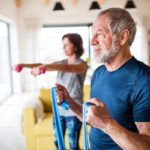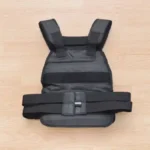
How to Choose a Weighted Vest: Tips for Buying the Right One
Key Takeaways:
Define Your Fitness Goals: Before buying, determine if you need a weighted vest for strength training (heavier, 20-40 lbs), endurance/cardio (lighter, 10-20 lbs), or weight loss (lighter, 10-15 lbs) to guide your weight selection.
Prioritize Adjustability: Opt for a weighted vest with adjustable weight plates to allow for progressive overload as your strength and endurance improve.
Material Matters for Comfort & Durability: Choose vests made from breathable and durable materials like mesh fabric for intense cardio or neoprene for a snug fit. Ensure it can withstand your intended use.
Focus on Fit and Comfort: A proper fit with adjustable straps, adequate padding in key areas (shoulders, chest), and breathable panels is crucial to prevent discomfort and chafing during workouts.
Consider Versatility: If you plan to use the vest for various activities (running, calisthenics, strength training), look for features like pockets and elastic straps that enhance its adaptability.
Balance Price and Quality: While premium vests offer advanced features, many affordable options provide excellent value. Set a budget and look for the best quality within that range.
Leverage Customer Reviews: Read reviews from other users, especially those with similar fitness goals, to gauge the vest’s reliability and effectiveness.
Choosing the right weighted vest can make all the difference in achieving your fitness goals. Whether you’re looking to enhance your workout, boost endurance, or add resistance training to your routine, a weighted vest can provide a challenging yet effective way to elevate your fitness regime. With so many options on the market, it’s essential to know what to look for before making your purchase. In this guide, we’ll break down the key factors to consider when buying a weighted vest to ensure that you make an informed and beneficial choice.
1. Consider Your Fitness Goals
Before diving into the specifics of weight and material, it’s important to understand your fitness goals. Different weighted vests are designed with varying purposes in mind, such as:
Strength Training: A heavier vest (20-40 lbs) is ideal for those looking to increase muscle mass and strength.
Endurance and Cardio: Lighter vests (10-20 lbs) can help with increasing stamina and improving cardiovascular health.
Weight Loss and Calorie Burn: If you’re focused on burning calories and enhancing calorie expenditure during your workout, a lighter vest (around 10-15 lbs) can make a significant impact.
Having a clear understanding of what you aim to achieve with a weighted vest will guide you toward the correct weight and design.
2. Weight Capacity and Adjustability
One of the most crucial factors when choosing a weighted vest is determining the right weight for your needs. Most weighted vests allow you to adjust the weight by adding or removing individual weight plates. This feature is essential because it allows you to progressively increase the resistance as your strength and endurance improve.
Lighter Vests: For beginners or those just starting, look for vests that offer a weight range of 10-20 lbs. This weight is perfect for improving endurance and performing bodyweight exercises.
Heavier Vests: Advanced users who want to build strength and add more resistance to their workouts should consider vests in the 20-50 lb range.
Make sure the vest you choose has adjustable weight options to allow for gradual progression.
3. Material and Durability
The material of the vest plays a major role in its durability and comfort. You’ll want a vest that is both strong and breathable to withstand tough workouts while keeping you cool. Look for vests made from:
Neoprene: Provides a snug, flexible fit and is lightweight, but may not be as breathable.
Mesh Fabric: Ideal for breathability and moisture wicking, keeping you cool during intense cardio sessions.
Cotton/Polyester Blends: Durable and comfortable but may trap heat more than mesh.
Durability is especially important if you plan to wear the vest outdoors, so opt for a vest made of high-quality materials that can withstand wear and tear.
4. Fit and Comfort
A weighted vest should fit securely without restricting movement. Most vests come with adjustable straps around the chest and waist, ensuring that you can customize the fit for maximum comfort. When choosing a vest, keep the following in mind:
Size Options: Some vests are available in multiple sizes to accommodate different body types. Be sure to check the sizing chart provided by the manufacturer to find the best fit for your body.
Padding: Look for a vest with padding in key areas like the shoulders and chest to prevent chafing or discomfort during long workouts.
Breathable Panels: A vest with mesh or breathable panels can reduce sweating and provide more comfort during intense exercises.
5. Versatility
Many weighted vests are designed for multiple types of exercises, from running and walking to calisthenics and strength training. If you plan to use your vest for various activities, choose one that’s versatile enough to accommodate a wide range of exercises. Some vests are designed with extra features like:
Pockets for Small Accessories: Some vests have pockets to hold your phone, keys, or other small items during your workout.
Elastic Straps for Movement Flexibility: Adjustable elastic straps can help you move freely during exercises like squats or lunges.
The more versatile the vest, the better it can adapt to your evolving workout routine.
6. Price and Quality
As with any fitness equipment, the price of weighted vests can vary widely depending on the brand, materials, and features. While a higher price tag often means better quality, there are plenty of affordable options that provide great value.
Premium Vests: Typically made of high-quality materials and offering advanced features like breathable fabric, durable straps, and adjustable weights, premium vests can cost anywhere from $100-$200.
Budget Vests: If you’re on a budget, look for options between $50-$100 that still offer adjustable weight and a comfortable fit. You might sacrifice some advanced features, but you can still get a good workout.
Ensure you’re getting the best value for your investment by considering both the quality and price of the weighted vest.
7. Customer Reviews and Recommendations
Lastly, one of the best ways to assess a weighted vest is by reading customer reviews. Look for feedback from people with similar fitness goals to yours. Positive reviews are a good indication that the vest is reliable and effective. Consider checking reputable platforms online and on social media for user experiences and recommendations.
The “Simple & Punchy” Conclusion
Choosing the right weighted vest can make a significant difference in achieving your fitness goals, whether you’re looking to build strength, enhance endurance, or burn more calories. Keep your goals in mind, consider the vest’s weight, material, comfort, and price, and always look for options with adjustable weights for progressive training. By carefully selecting the right weighted vest for your needs, you’ll set yourself up for success in your fitness journey.
The Vest Whisperer: Your Burning Questions Decoded!
What is the best weight for a weighted vest for beginners?
For beginners, a weighted vest with a range of 10-20 lbs is generally recommended. This allows for improved endurance and effective bodyweight exercises without excessive strain.
How do I know what weight weighted vest to buy for strength training?
For strength training, heavier vests in the 20-40 lbs range are typically ideal. The exact weight depends on your current strength level and specific exercises you plan to perform. Look for adjustable options to gradually increase resistance.
Is a heavier weighted vest always better?
Not necessarily. The “best” weight depends entirely on your fitness goals. A heavier vest is better for building muscle mass and strength, while a lighter vest is more effective for endurance, cardio, and calorie burning.
What material is best for a weighted vest for running?
For running and intense cardio, vests made from mesh fabric are ideal due to their excellent breathability and moisture-wicking properties, which help keep you cool and comfortable.
How important is adjustability in a weighted vest?
Adjustability is crucial. A vest that allows you to add or remove weight plates enables progressive training, meaning you can increase the resistance as you get stronger and fitter, making it a long-term investment for your fitness journey.
Can I use a weighted vest for activities other than just working out?
Yes, many weighted vests are designed for versatility. You can use them for various activities like walking, hiking, calisthenics, bodyweight exercises, and even some sports drills to add resistance and increase calorie expenditure.
How much should I expect to pay for a good weighted vest?
The price of weighted vests can vary widely. Budget-friendly options typically range from $50-$100, while premium vests with advanced features and high-quality materials can cost anywhere from $100-$200. Focus on getting the best value for your investment based on your needs.



